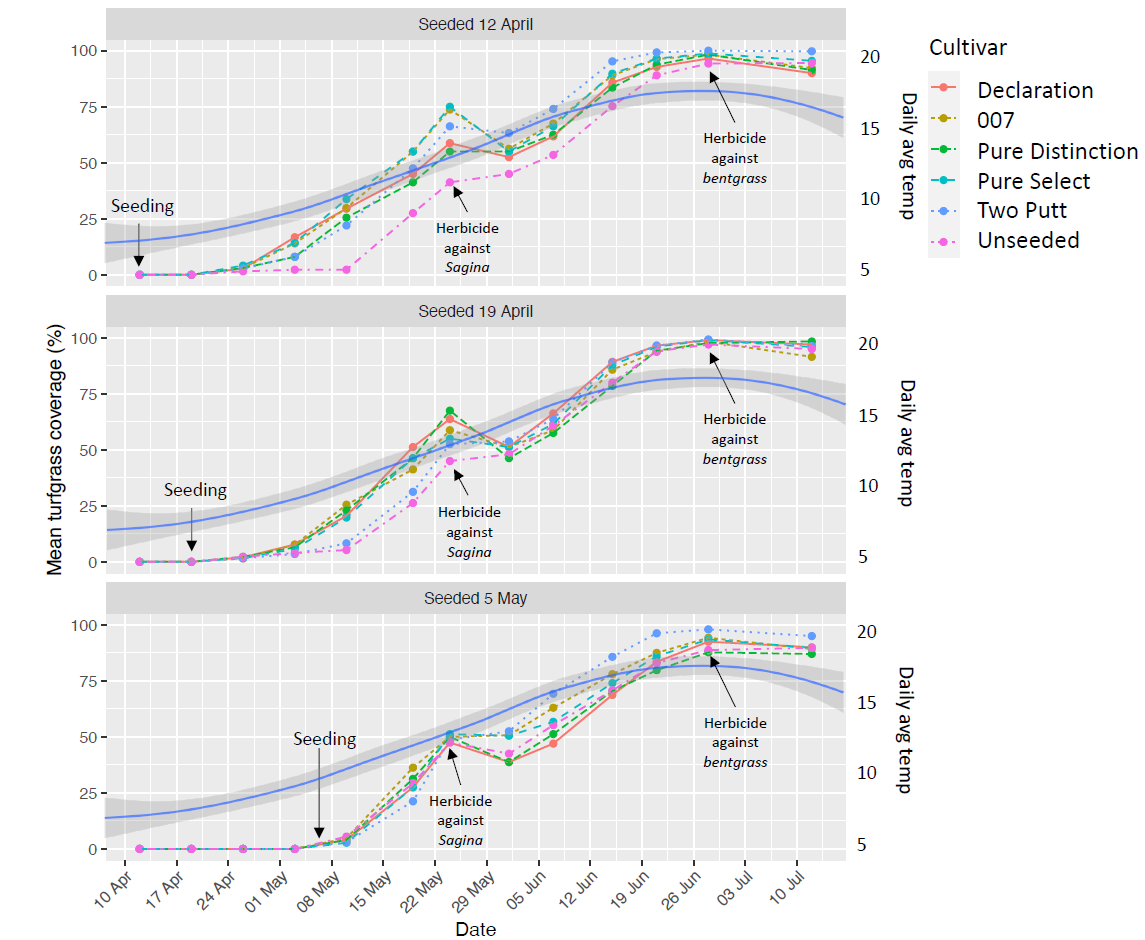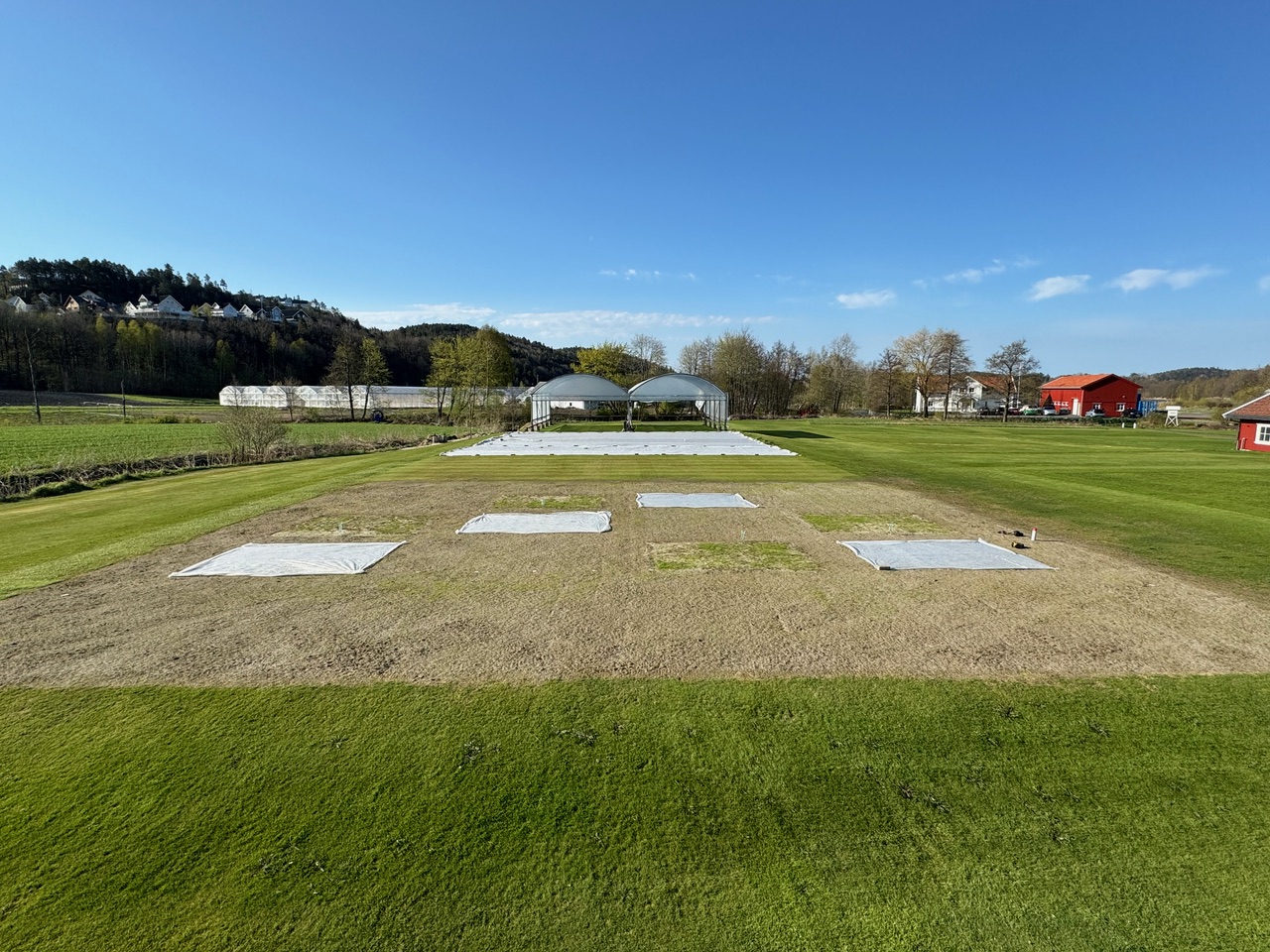By Michael Bekken and Trygve S. Aamlid, Norwegian Institute of Bioeconomy Research (NIBIO)
Golf courses with annual bluegrass putting greens that experience severe winter injury may wish to convert to bentgrass varieties. This research is meant to test the feasibility of such attempts and the effects of seeding date on the success of bentgrass establishment.
In 2023 the study began on NIBIO annual bluegrass green in Landvik, Norway. The trial began by simulating winter kill by applying glyphosate to the green in early spring. Four different cultivars of creeping bentgrass (Agrostis stolonifera) were then seeded which included ‘Declaration’, ‘007’, ‘Pure Distinction’, and ‘Pure Select’. One variety of annual bluegrass (Poa annua), ‘Two Putt’, was also seeded. The sixth and final treatment was a control plot that was left unseeded.
Unfortunately, in 2023 the early spring application of glyphosate was not effective in simulating a major winter kill event, as evidenced by the unseeded plot retaining similar coverage to the seeded plots (Figure 1). In addition, an herbicide to kill the bentgrass was applied in late June, which did not decrease turfgrass coverage, meaning that very little, if any, bentgrass was present at this point.

To simulate a major winter kill event, we decided to apply glyphosate to the annual bluegrass green in fall 2023 in preparation for the experiment to repeat in spring 2024. Scouting of the green in early spring 2024 revealed the green to be absent of any living annual bluegrass plants. As such, all annual bluegrass that grows on the green this year (in 2024) has likely originated from the seed bank. We are confident that our experiments this year simulate the event in which a golf course’s annual bluegrass greens are completely killed by winter damage.
Beyond simply assessing the ability of creeping bentgrass to establish on a winter-killed annual bluegrass green, an additional aim of this study is to determine the optimal seeding date to quickly reestablish turfgrass coverage. The study includes three seeding dates. The first seeding date was to be planted when soil temperatures at 5 cm (2 in.) were 5-7.5°C (41-45.5°F), the second at 7.5-10°C (45.5-50°F), and the third at soil temperatures of 10-12.5°C (50-54.5°F).
However, due to this year’s spring, which had widely varying temperatures and periods of snow cover, the first seeding was not possible until soil temperatures had reached 7.4°C (45°F) on April 8. Two weeks later on April 23, soil temperatures had actually dropped to 5.6°C (42°F), but we decided to seed regardless (Figure 2). Finally, on May 5 we seeded the third and final plots with soil temperatures at 11°C (52°F).

While the data has not been formally analyzed yet, as of this writing in mid-May, the plots that were seeded first (on April 8) have the highest coverage of the three seeding dates. In terms of species and cultivars, ‘007’ and ‘Pure Select’ creeping bentgrass, and ‘Two Putt’ annual bluegrass had approximately 70% coverage, the highest in the study to date. Plots of ‘Declaration’ and ‘Pure Distinction’ creeping bentgrass both had percent cover around 50% while unseeded plots had approximately 20% cover. We plan to continue the experiment until late June, when we will again apply an herbicide that kills the creeping bentgrass, at which point we can measure the success of the bentgrass establishment.
For golf course managers that are in the unfortunate position of needing to completely reestablish winterkilled greens, we hope this research will provide information and evidence to guide their seeding date decisions and species and cultivar choices for the fastest possible reestablishment of a desirable putting green grass. As the climate here in Scandinavia warms faster than the global average and the number of freeze-thaw cycles continues to increase, we anticipate that unfortunately, this research will become increasingly relevant to Scandinavian golf course superintendents.
About the turfgrass group at NIBIO Landvik
This research is being conducted by the turfgrass group at NIBIO, which is located in southern Norway, about 45 minutes from the southern Norwegian city of Kristiansand. The Landvik research station was established in 1952 and today is one of the leading turfgrass research centers in Europe, with 5 full-time researchers and 3 full-time technicians. The research group primarily focuses on turfgrass variety testing, nutrient and water conservation in turfgrass systems, turfgrass IPM, and robotic mowing.